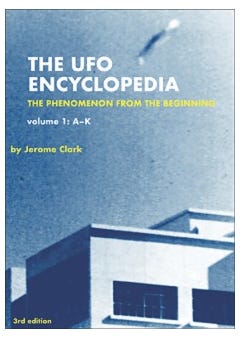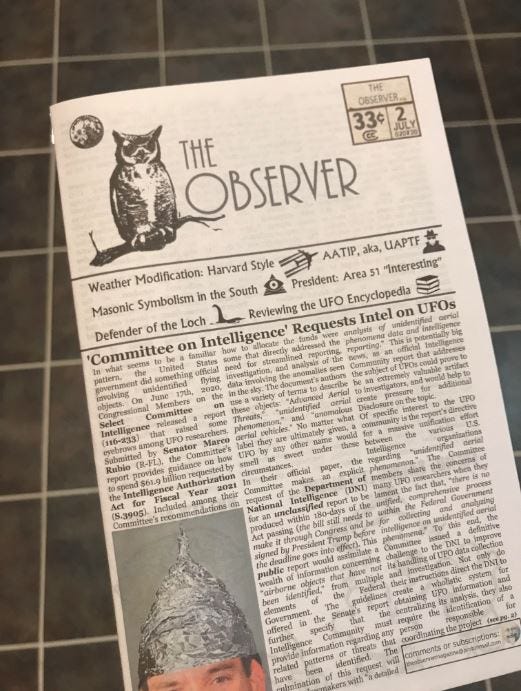Books Your Parents Warned You About: The UFO Encyclopedia
Book Review: The UFO Encyclopedia by Jerome Clark
Our first official book review is a bit unconventional, as we open with the magnum opus by Jerome Clark, a long-standing authority in the area of unidentified flying objects and their history. The UFO Encyclopedia: The Phenomenon from the Beginning consists of two oversized, hardcover volumes. The third edition is the latest update to this collection of the author’s three previously published books, cataloging the topic from its early roots up through today. The most recent version has been restocked with close to 60 new entries, citing events as recent as the revelations of AATIP and the famous 2017 New York Times article, identified by many as the progenitor of the state of UFOlogy today. Despite the fact that information of this kind is fluid and changes rapidly, Clark’s assembled pieces stand the test of time and hold an exhaustive, detailed look at the history of the people, places, and events that forged the UFO arena through the years.
You won’t find the typical dry, scholarly articles void of opinion or narrative voice that you’d expect out of a book with the word ‘Encyclopedia’ in its title. Clark skillfully imbues his writing with the authority of someone who has spent countless decades on the front lines of paranormal journalism. He is able to carefully navigate the boundary between hardcore believer and outright skeptic and, in doing so, creates a reliable narrator throughout the work. His writing style is very accessible; we were able to read the book for long stretches at a time, remaining engaged in the information and how it's presented. It helped that the selected entries, despite all being in the realm of UFOs, were varied enough to avoid being repetitive in the course of one sitting. Admittedly, this is a feat for any writer, especially when considering the lack of cohesive narrative across topics in encyclopedia format; thus, it makes Clark’s achievement all the more impressive.
The collection does a solid job of curating the right assortment of subject matter to represent the phenomenon. Some entries are multiple pages long, allowing the writer to delve deep into every nuance and explanation of an incident. He reports on a pleasantly diverse range of topics, tackling everything from airship sightings of the late 1800s, to a well-researched exposé on famous debunkers and their explanations of notorious encounters.
We felt there were a few too many unimportant or irrelevant eyewitness reports and individual anecdotes that made the final cut, which Clark should have omitted. Still, most of the inclusions are worthwhile and their level of detail helped to deepen our knowledge on interesting developments in the field over the previous decades.
After reading the entire first volume (letters A-M) some of the author’s personal leanings started to become apparent. Clark is not a big fan of the contactee movement of the 1950s, or of one of its infamous leading figures in particular: the late George Adamski. Clark can’t help but tip his hand, exposing his true feelings when he warns that “skepticism is clearly warranted” when dealing with Adamski’s claims. He devotes a full 10 pages to the individual, which is more than he gives to most topics, and ends the debate on the contactee’s authenticity by reminding us that any “claims of interplanetary adventure and discourse are not true in ordinary understanding of the adjective.”
Conversely, he approaches other hotly debated and criticized incidents, like the seminal Betty and Barney Hill abduction (Hill Abduction Case), from a more open-minded and sympathetic viewpoint. Emphasizing their reluctance to go public with their 1961 story, Clark laments that “[l]ike it or not the Hills were about to become UFO celebrities.”
An aspect of the books that we especially appreciated was the enormous amount of citations and sources that were provided. The author is a meticulous documenter, as evidenced by the comprehensive bibliographies included after each topic. He cites so many references that some of the bibliographies are longer than the articles they support. All of this is to commend Clark for being so thorough and providing his readers with a litany of primary sources and material to explore if they want further information on any topic.
A quick word on their physical appearance: Jerome’s tomes are well put together. The binding and spine are tight and sturdy and the volumes look sharp next to each other on a bookshelf. The interior layout is a classic dual-column text format, and the author includes a healthy amount of black & white photographs to accompany his writing. The encyclopedia is organized in alphabetical order and each letter contains anywhere between 10-20 entries.
If there is one major flaw with the collection, it lies in the absence of rigorous proofreading. There are too many misspelled words and too much incorrect punctuation for a work being advertised as ‘academic’ concerning the UFO subject. The editing miscues risk distracting readers from the thoughtful research and solid reporting that Clark put into the final product. We expected higher attention to these editorial details before publishing a third edition of a work that seeks to represent a field of study that is in a constant struggle for its credibility.
There were also a few topics that felt unbalanced in their coverage. We were surprised to find some significant items which were sparsely covered or excluded all together, while less critical aspects were given ample word count. A section titled NASA and UFOs clocked in at a disappointing four pages, and a piece about the controversial “Estimate of the Situation” (an alleged government study that concluded E.T.s were the most likely source of UFOs) was summed up in an underwhelming 11 paragraphs. Items such as Area 51 and Zecharia Sitchin (the famous ancient alien theory originator) were conspicuously missing their own standalone entries, despite their widely recognized importance in the UFO department. Meanwhile, an overabundance of space is wasted outlining redundant and unnecessary examples of the 3 types of Close Encounters (CE1-3). These amount to little more than page upon page of eyewitness anecdotes, many of them far-fetched.
Clark and his collection are decidedly at their best when they stick to more in-depth and robust deconstructions of specific cases. The way Clark recounts the intricate theories and grand personalities involved in what he calls the “Dark Side” of the ET hypothesis (an evil co-plot between governments on earth and extraterrestrials to enslave humanity) is a riveting example of his prowess for making such esoteric topics digestible to a wide audience.
We ordered our copy directly from the publisher (Omnigraphics) since they were the lowest priced option. At a cool $139, the set isn’t cheap. However, when considering the difficulty in finding quality material on the UFO topic, the price tag for the page count is put into perspective. Jerome Clark ultimately analyzes the phenomenon from a variety of angles - never straying too far from the journalistic method and style that makes this an authentic and readable collection.








